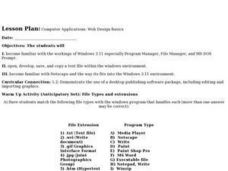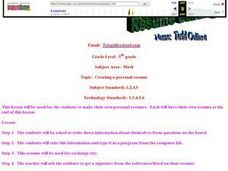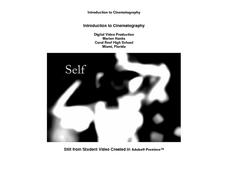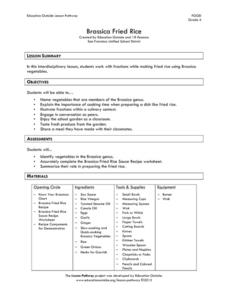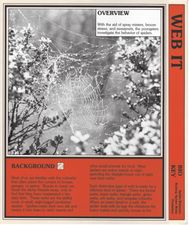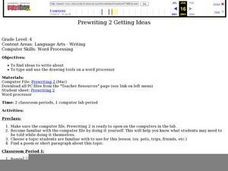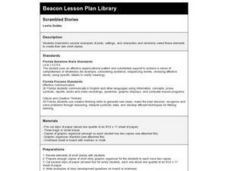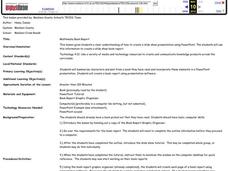Have Fun Teaching
Compare and Contrast Greek Myths (4)
How are Icarus and Prometheus similar? How are they different? Compare any two Greek myths with a graphic organizer, which provides space for kids to fill in the ways that the myths are like and unlike each other.
Curated OER
Technology: Programming Graphics
Students use the DrScheme program to create graphics for clip art. Using graphics, they plan their designs using basic shapes, plotting its positions, and studying the relationships between points. By plotting the necessary data on...
Curated OER
Breaking News English: Court Jails Pirate Bay File Sharers
For this English worksheet, students read "Court Jails Pirate Bay File Sharers," and then respond to 2 graphic organizers, 47 fill in the blanks, 7 short answers, 20 matching, and 8 true or false questions about the...
Curated OER
Computer Applications: Web Design Basics
Students become familiar with the workings of Windows 3.11 especially Program Manager, File Manager, and MS DOS Prompt. They open, develop, save, and copy a text file within the windows environment. They become familiar with Netscape and...
Curated OER
Paragraph Writing
Third graders receive Gummi hamburgers. They discuss parts and structure of a (real) hamburger. Students dissect the gummi hamburger and rearrange the pieces. Students discuss the problems that would be caused by this with a real...
Curated OER
Going by the Rules
Students examine George Washington's Rules of Civility. In this George Washington lesson, students investigate how rules influence people, and the roles of citizens in America. Students will discuss and reword rules and work in...
Curated OER
Political European Motives in Africa
In this African colonization worksheet, students respond to 4 short answer questions that accompany a reading selection about political motives in Africa. Students also complete a graphic organizer based on the selection.
Florida Center for Reading Research
Vocabulary: Word Meaning, Undercover Meanings
Support young scholars with studying new vocabulary using this foldable resource. By cutting and folding the included template, learners can record definitions, examples, and a sentence for four different words.
iCivics
Limiting Government
While this lesson includes several nice worksheets to identify and discuss the various limits on government (i.e. a constitution, the rule of law, separation of powers, consent of the governed, etc.), its main value lies in a case study...
Curated OER
Creating a Personal Resume
Fifth graders be asked to write down information about themselves from questions on the board. They take this information and type it in a program from the computer lab. The resume will be kept in their expandable file for future reference.
Oregon State
Introduction to Cinematography
Places everyone! Action! Imagine an entire cinematography course, already designed, that includes everything you need to launch your own film studio, in one tidy 66-page packet.
Agriculture in the Classroom
Chocolate Taste-Testing: Introduction to Loco for Cocoa
Is the price of chocolate a good indicator of taste? Your learners will approach this question through experimentation and analysis, and will then delve into the rich history and complexity of cacao and chocolate.
Curated OER
Beowulf: Lesson Plan and Supplementary Materials
A reading of Beowulf: Dragon Slayer, Rosemary Sutcliff's retelling of the classic epic poem, launches an exploration of what it means to be a hero, a noble leader, and a great warrior. A great way to introduce middle schoolers to...
Education Outside
Brassica Fried Rice
Here's a delicious way to engage fourth graders into working with fractions. Kids chop brassica or cruciferous vegetables, measure the required ingredients, and add them to cooked rice to produce a delicious treat.
National Energy Education Development Project
Introduction to Wind Energy
The U.S. produced enough wind energy in 2015 to power all of the homes in Alaska, California, Delaware, the District of Columbia, Hawaii, Idaho, Maine, Montana, Nebraska, New Hampshire, North Dakota, Rhode Island, South Dakota, and...
Read Works
Figurative Language
Here's a richly detailed unit, designed for second graders, that focuses on decoding figurative language, including similes, metaphors, personification and idioms.
Ministry of Education - Ontario
Reading Between the Lines
Learning to read between the lines, to recognize the on-the-surface meaning as well as the implied or inferred meaning of text, is an important skill for all readers. The materials and activities in this 73-page packet are designed to...
Curated OER
Web It!
Looking for a way to bring prewriting into your informative writing unit? Use this lesson to reinforce writing skills in your eighth grade language arts class. Young writers use a web graphic organizer as a prewriting tool for expository...
Curated OER
Prewriting 2 Getting Ideas
Fourth graders read a poem or short paragraph and have students picture it in their minds. They relate the topic to something in their experience and illustrate, 4th graders generate questions with a graphic organizer, use Prewriting2...
Curated OER
Scrambled Stories
Character development, setting, and plot? Sounds like the makings of a good narrative story. Young authors read and analyze several narrative examples, and then they use what they know to pen an original composition. They work both in...
Curated OER
Five Elements of a Story
Here’s a graphic organizer that permits learners to chart the introduction, rising action, climax, falling action and resolution of a story. The PDF file can be customized to work with any narrataive.
Curated OER
Why Do Authors Write?
Sixth graders use short reading passages to identify, explain, and discuss the author's purpose for writing. After a lecture/demo, they utilize a graphic organizer embedded in this plan to organize their writing ideas.
Curated OER
Multimedia Book Report
Learners take a book they've read previously and create a multimedia book report. They use the book report graphic organizer (attached) to plan their PowerPoint presentation. A thorough rubric is provided for you to ease grading. There's...
Curated OER
What's Below the Earth's Surface?
Students identify the geological layers of the Earth. They graphically depict each layer's characteristics. Students label and develop a color key for their exhibit. They create a down-to-Earth 3-D display with Erasable Markers.



